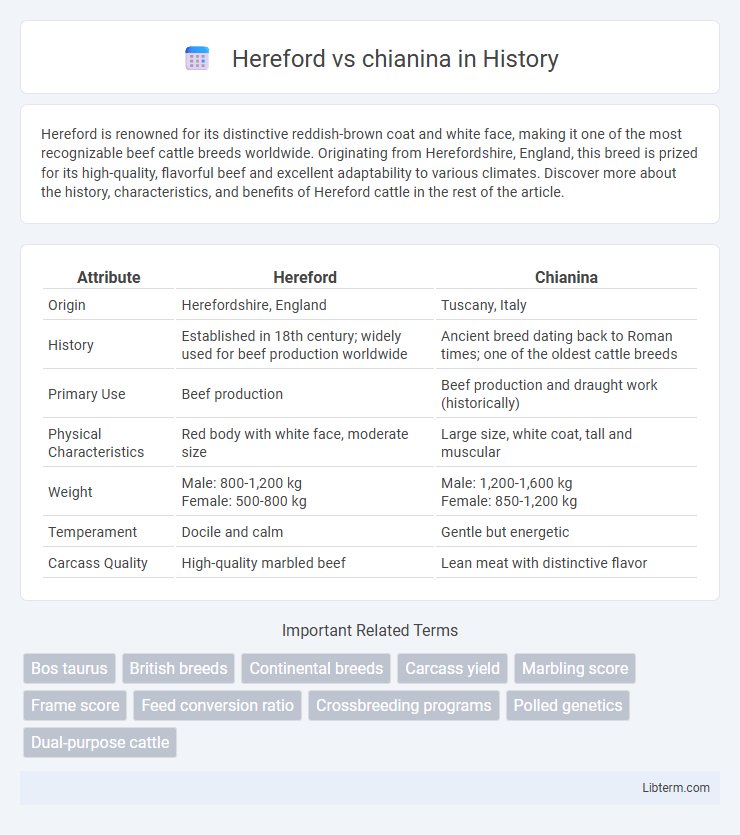Hereford is renowned for its distinctive reddish-brown coat and white face, making it one of the most recognizable beef cattle breeds worldwide. Originating from Herefordshire, England, this breed is prized for its high-quality, flavorful beef and excellent adaptability to various climates. Discover more about the history, characteristics, and benefits of Hereford cattle in the rest of the article.
Table of Comparison
| Attribute | Hereford | Chianina |
|---|---|---|
| Origin | Herefordshire, England | Tuscany, Italy |
| History | Established in 18th century; widely used for beef production worldwide | Ancient breed dating back to Roman times; one of the oldest cattle breeds |
| Primary Use | Beef production | Beef production and draught work (historically) |
| Physical Characteristics | Red body with white face, moderate size | Large size, white coat, tall and muscular |
| Weight | Male: 800-1,200 kg Female: 500-800 kg |
Male: 1,200-1,600 kg Female: 850-1,200 kg |
| Temperament | Docile and calm | Gentle but energetic |
| Carcass Quality | High-quality marbled beef | Lean meat with distinctive flavor |
Hereford vs Chianina: An Introduction
Hereford and Chianina are two prominent cattle breeds known for their distinct characteristics and meat quality. Hereford cattle are prized for their adaptability, docile temperament, and marbled beef that offers rich flavor and tenderness. Chianina, one of the largest and oldest cattle breeds, stands out for its lean meat and exceptional muscle development, making it a preferred choice for high-quality steaks.
Origin and History of Hereford and Chianina
Hereford cattle originate from Herefordshire, England, with a history dating back to the 18th century where they were primarily bred for beef production and adaptability to temperate climates. Chianina cattle hail from the Valdichiana area of Tuscany, Italy, known as one of the oldest and largest cattle breeds, historically valued as draft animals before becoming prized for their lean, high-quality beef. Both breeds have distinct genetic lineages and have played significant roles in the development of modern beef cattle worldwide.
Physical Characteristics Comparison
Hereford cattle exhibit a distinctive red body with white face and underbelly, known for their medium size and sturdy, muscular build suited for beef production. Chianina cattle, originating from Italy, are one of the largest and tallest breeds, characterized by their short white or grey coat and strong, lean physique, often used in draft work and beef. The Chianina's height advantage and longer legs contribute to greater weight and stature compared to the more compact and stocky Hereford breed.
Temperament and Behavior Differences
Hereford cattle are renowned for their docile and calm temperament, making them easier to handle in various farming environments. In contrast, Chianina cattle tend to be more alert and occasionally skittish, requiring experienced handlers to manage their more energetic behavior. These behavioral distinctions impact their suitability for different livestock operations, with Hereford favored for ease of management and Chianina valued for its adaptability and vigor.
Adaptability to Different Climates
Hereford cattle exhibit exceptional adaptability to a wide range of climates, thriving in both cold and temperate regions due to their thick, dense coat and robust health. Chianina cattle, originating from Italy, are better suited to warmer, Mediterranean climates and can struggle in colder, more humid environments. The genetic resilience of Hereford breeds contributes to their versatility in diverse environmental conditions, making them a preferred choice in varied geographic locations.
Growth Rate and Maturity
Hereford cattle exhibit a moderate growth rate, reaching maturity around 18 to 24 months, making them suitable for traditional beef production cycles. Chianina cattle, one of the largest and oldest breeds, show a slower initial growth rate but achieve greater final size and weight, with maturity often taking up to 30 months. The longer maturation period of Chianina results in higher muscle mass and carcass yield compared to the more rapidly maturing Hereford breed.
Meat Quality and Yield Analysis
Hereford beef is renowned for its superior marbling, tenderness, and rich flavor, making it highly prized in premium meat markets, while Chianina offers exceptional lean meat with a robust texture and slightly lower fat content. In yield analysis, Hereford cattle typically provide moderate carcass weights with higher fat distribution, enhancing eating quality, whereas Chianina excels with larger carcass weights and leaner cuts, contributing to higher retail yield and lower trimming loss. Meat quality characteristics of Hereford prioritize sensory attributes, whereas Chianina focuses on efficient meat production and volume, catering to differing consumer preferences and industry demands.
Feeding and Management Requirements
Hereford cattle require moderate-quality forage and benefit from rotational grazing systems to optimize weight gain and milk production, with supplemental grain often provided during winter or drought periods. Chianina cattle, known for their large size and muscularity, demand higher energy diets rich in proteins and minerals, necessitating intensive feeding regimens including silage, commercial concentrates, and frequent health monitoring to support growth and reproductive performance. Effective management for both breeds involves tailored nutrition plans to meet their specific metabolic rates, ensuring optimal feed conversion efficiency and overall herd health.
Advantages and Disadvantages of Each Breed
Hereford cattle are renowned for their adaptability to various climates, excellent feed efficiency, and superior beef marbling, which enhances flavor and tenderness, but they may have slower growth rates compared to other breeds. Chianina cattle offer remarkable size and growth speed, producing lean, tender meat with lower fat content, although they require more intensive management and specific environmental conditions for optimal performance. Both breeds have unique advantages: Hereford's resilience and meat quality versus Chianina's rapid growth and lean beef, with disadvantages tied to their specific care and growth needs.
Choosing Between Hereford and Chianina for Your Farm
Choosing between Hereford and Chianina cattle involves evaluating traits like adaptability, growth rate, and meat quality. Hereford cattle are renowned for their hardiness and efficient feed conversion in temperate climates, making them ideal for diverse environments. Chianina cattle, one of the tallest breeds, excel in producing lean, high-yield beef with a fast growth rate, suitable for farms focusing on premium beef production.
Hereford Infographic

 libterm.com
libterm.com